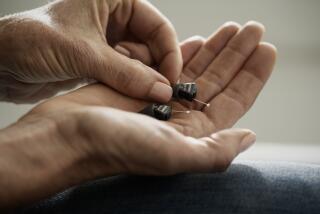For a generation that loved loud music, hearing loss calls
- Share via
Having trouble getting the buzz at the party because there’s too much, er, buzz? Do those S’s, F’s, T’s and Th’s sound alike?
A growing number of 40- and 50-somethings, baby boomers who grew up on rock music, played in bands and enjoyed living loud, are seeking a new form of high-tech relief: Digital hearing devices that help recapture the high-pitch frequency sounds they’re beginning to lose.
A 2004 study by the Better Hearing Institute shows that more than 12 million people ages 45 to 64 are encountering hearing problems, and that two-thirds of Americans with hearing loss are below retirement age.
Another survey by the Ear Foundation projects that nearly half (49%) of the baby boomers are having difficulty with their hearing. More than half report difficulty using cellphones because of hearing loss while 75% say they find themselves in situations where people are not talking loudly enough or clearly enough.
Bill Clinton, Phil Collins, Bono, Eric Clapton and Cher are among the boomers who have experienced hearing loss.
“This is a generation that has grown up with very loud music and in a world with a lot of environmental noise like power mowers and leaf blowers,” says Sharon Beamer, associate director for audiology professional practices of the American Speech-Language-Hearing Assn. “But the biggest issue is music: concerts, personal hearing systems like Sony Walkmen turned up very loud. Noise exposure is one of the most common causes of hearing loss.”
Often avoided by previous generations as clunky, unsightly, difficult and stigmatizing, hearing aids are becoming more acceptable, if not exactly desirable.
Attitudes are changing in part because of the design and advanced technology of these devices and in part because everyone seems to have a Bluetooth or an iPod hanging over, or out of, their ears, says Baltimore audiologist Deborah Doyle Allen.
There’s also the incentive of being able to hear what the boss is saying at those two-hour meetings.
Allen, 54, uses one of the market’s hippest new devices: The Delta by Oticon. She says her hearing loss stems from noise exposure -- “machinery and going to concerts” -- as well as a strong family history.
Being in the business, she began noticing her hearing loss earlier than most. About five years ago, she realized she was missing out on high-frequency sounds and some consonants.
“There are certain birds I can’t hear anymore,” she says. “Also cicada and tree frog kind of sounds. In speech, it’s more difficult to differentiate between words like “tape’ and ‘take’ and ‘cake.’ The hearing loss makes it more difficult to distinguish the speech attributes we need for understanding and intelligibility.”
Half of the people older than 50 have trouble understanding speech in noisy listening situations, according to the Ear Foundation.
Allen wears a “champagne beige” Delta. The tiny triangle-shaped device, which sells for between $1,500 and $3,000, comes in 17 colors including cabernet red, samoa blue, mother of pearl and a leopard skin-pattern. And whenever she goes to a pop or rock concert, she slips in custom earplugs to help preserve her hearing.
To prevent accelerated hearing loss, she says, people should begin wearing hearing devices as soon as they become aware of a deficit.
That helps preserve the brain’s memory and recognition of the sound, which is essential to what we consider “hearing.”
Allen describes herself as a “situational user” who reserves her hearing aid mostly for meetings, lectures and restaurants. She wears the device in her right ear, where she has a “very mild decrease” of hearing.
John Moraski, director of transmission at BG&E;, says he wore his flesh-colored behind-the-ear hearing aids for days before anyone noticed. In fact, he had to point them out to his family.
“I had a conventional hearing aid for two years and couldn’t stand it,” he says. “Whenever I talked, I felt like I had my head in a bucket. Now, I hear so clearly that when I take them out, I feel like I have a pillow over my head.”
The 56-year-old Parkville, Md., resident used to play bass guitar in L’Amoure, a band that performed at local parties and clubs in the late ‘60s and early ‘70s.
“I’m still a very big fan of music,” he says. “I noticed once I got the hearing aids, I adjusted all my stereo settings, turned the treble down. And my wife says I don’t play the TV as loud or talk as loud.”
He says his wife, Pat, doesn’t need a high-tech hearing device. When it comes to hearing clearly, there’s definitely a gender gap: The Ear Foundation reports that 62% of the boomers having trouble are men.
*
(BEGIN TEXT OF INFOBOX)
Now hear this
Americans who have lost some hearing have plenty of company. According to the Better Hearing Institute, the afflicted include:
* 31.5 million people, one in every 10.
* 15% of those ages 45 to 64.
* 65% are below retirement age.
* About 60% are men.
For more information about hearing loss and ways to address it, visit the Better Hearing Institute website at betterhearing.org. The site has a written test to see whether you may be experiencing some hearing loss. The survey site is betterhearing.org/hearing_loss/quickHearingCheck.cfm.
To find an audiologist near you for a hearing test, consult the American Academy of Audiology at audiology.org.
Source: The Better Hearing Institute





